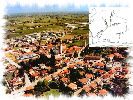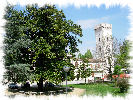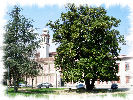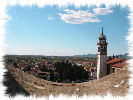Tribano
The village, that lies in the river Po plain, has agricultural origins, however it has seen a slow but constant development. Its big late baroque church was built in 1731, its statues and frescoes were ended in the year 1800. The historic tower rises in the garden of the municipal palace where there is a majestic magnolia of a record size. Tribano was famous perhaps because the old course of the river Adige crossed it, but at present it has green areas that are looked after with care by its inhabitants, it has also a recently rebuilt beautiful square. In the library several didactic courses are held and in the multiple use room you will find a meeting place where society problems are dealt. The various sport activities and the end of the year parties are organized in the gymnasium which is built inside the school area. A great reference place is also the nursery school; there are tennis courts and football fields, too. For people fond of horse-riding there are riding schools not far from the center.
In many crossroads you will see capitals with a statue of Our Lady on them; they were built between 1917 and 1950 on the occasion of the year of Mary. The several small roads, that almost all run through the open countryside, lead to the “Via del Mare”, that in Tribano is known as the Superstrada (the Highway). These small roads are very beautiful to be seen on foot or by bicycle! The very good geographical position allows a quick move to:
CHIOGGIA, VENICE, PADUA, VICENZA, VERONA, ROVIGO, BOLOGNA, FERRARA, MONSELICE, ESTE, MONTAGNANA, SOTTOMARINA, CONSELVE.Two hamlets are part of Tribano: Olmo, with its beautiful church built in ancient stone, keeps a very fine Madonna (a wooden statue made with the hundred-year-old elm, symbol of the hamlet), San Luca that is famous for its church, but also for the sopressa festival (the sopressa is a tasty kind of big salami). San Luca's small roads often end into large country estates.
The Monselice motorway tollbooth is at 6 Kilometers from Tribano. Monselice, Este, Montagnana are walled towns at the foot of the Euganean Hills. Conselve has a rich chain of shops. It takes 30 minutes to arrive at the seaside (beaches of Sottomarina, Isola Verde, Rosolina Mare and Lidi Ferraresi).
BedMIN - Bed & Breakfast Country 2003/2014 All rights reserved - info@bedmin.com



